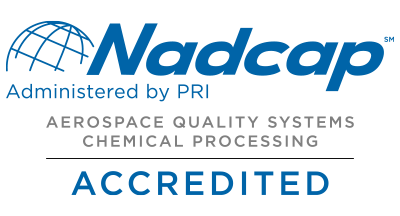Chem film or more appropriately chemical film is a term describing a chemical conversion coating most often associated with applying chromates to aluminum. The most widely known trade names for this process are Henkel’s Alodine® and MacDermid Enthone’s Iridite®. They are a category of sealants designed to adhere to the surface of metal components to provide a protective layer against corrosion.

Chem Film Has Many Benefits
In addition to enhanced corrosion protection, there are many practical benefits to using chem film coatings including:
- Ideal primer to help paints, adhesives and other organic topcoats adhere
- Prevent fingerprinting of soft metals
- Quick and easy application by immersion, spray or brush
- Fewer steps than most chemical processes thus economical and cost-efficient
- Provide reliable electrical connection between parts
- Thin coating, nearly immeasurable, so does not change part dimensions
While most often associated with coating aluminum, chromate conversion coatings can also be applied to cadmium, copper, magnesium, silver, titanium and zinc.
Industries That Use Chem Film Coated Parts
Chem film and chromate conversion coatings are highly versatile, cost-efficient, and highly effective making them ideal for use by a wide range of the industry including:
- Automotive
- Aerospace
- Building & Architecture
- Electrical
- Marine
- Military & Defense
- Manufacturing
- Sporting & Consumer Goods
The Chem Film Process
Manufacturing facilities vary, but the chromate conversion process follows this basic sequence:
- All dirt, oil, grease and manufacturing residue are removed to permit the conversion coating chemicals to evenly coat the surface. These cleaners are typically non-etch, slightly alkaline detergents operated at moderately elevated temperatures followed by thorough water rinsing.
- Once clean, depending on the specific aluminum alloy, the surface may be treated in an acid or alkaline etch to remove alloying elements which might interfere with the conversion coating reaction. In general this step enriches the surface exposing more aluminum, such as for castings and more heavily alloyed materials. Care must be taken not to over-etch or remove too much material. Once again, this etch is followed by a thorough water rinse.
- Once etched, depending on the specific aluminum alloy, the surface is treated in an acid to remove the natural occurring oxide film as well as desmut the surface which might interfere with the conversion coating reaction. Once again, this deoxidation is followed by a thorough water rinse.
- Chem Film Coat. Finally the clean, etched, and deoxidized aluminum is ready for conversion coating. Traditionally, this was done in acidic hexavalent chromium solutions, however, in the last decade more and more non-hexavalent baths have become available and written into the applicable specifications. Following the conversion coating process, parts are rinsed and dried.
Types of Chem Film
As called out in the basic military specification governing such conversion coatings on aluminum, they are divided into types and classifications with unique properties depending on the application.
Type I. These are the traditional hexavalent chromium-bearing chem films. They may be more expensive to operate due to required ventilation, personal protective equipment to keep operators safe as well as additional wastewater treatment needed to reduce the hex chrome and precipitate the remaining chrome prior to discharge. The coatings can vary from faint yellow to dark gold. While nearly clear coatings are available, they offer limited corrosion protection, however, they offer the least electrical resistance.
Type II. These are the newer, non-hexavalent chromium or chromium-free processes. They are basically a drop-in replacement for Type I processes, but the basic sequence of operations remains unchanged. The baths are safer for operators and wastewater doesn’t require reduction of hex chrome to trivalent chrome making it more beneficial to use. Anoplate’s AnoChem TCP process is one such hexavalent-free, Type II, chem film.
Class 1A. In general Class 1A coatings are general purpose for corrosion resistance or paint adhesion. Again, they are typically more richly colored and provide optimum protection against harsh environments
Specifications
Chemical conversion coating, chem film, of aluminum is covered by the following specifications:
- MIL-DTL-5541 ( formerly MIL-C-5541 )
- AMS 2473 ( for general purpose, corrosion resistance )
- AMS 2474 ( for applications where low-electrical resistance is required )
- ASTM B449
- ASTM B921 ( for non-hexavalent chrome coating )
Durable, Dependable Chem Film Coatings From Anoplate
Anoplate maintains an extensive list of corporate approvals and certifications for applying both Class 1A and Class 3 chem film coatings in both Type I and Type II. We work in partnership with some of the industry’s largest and most respected suppliers of such specialty chemical technology. As your partner in the supply chain, our commitment to quality and professional service assures you that you’ve chosen the right supplier for your metal finishing needs.
Contact us today to learn more about our selection of chem film coatings.
--
Chem film, chemical film coating, chromate conversion coating, chem film process, chem film application, chem film vs anodizing, chem film corrosion resistance, chem film MIL-DTL-5541, chem film aluminum, chem film aerospace industry, anoplate.













